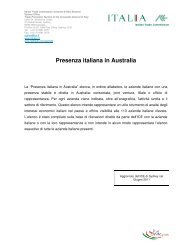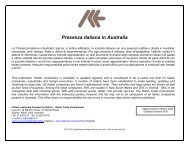Price Determination in the Australian Food Industry A Report
Price Determination in the Australian Food Industry A Report
Price Determination in the Australian Food Industry A Report
Create successful ePaper yourself
Turn your PDF publications into a flip-book with our unique Google optimized e-Paper software.
PRODUCER INTEGRATION<br />
Does <strong>in</strong>tegration provide better producer returns?<br />
A debate has arisen on <strong>the</strong> issue of whe<strong>the</strong>r <strong>the</strong> cooperative provides a better return to its<br />
producer-members than o<strong>the</strong>r models of supplier <strong>in</strong>tegration.<br />
What do cooperatives do for <strong>the</strong> producer when it comes to achiev<strong>in</strong>g a better price for <strong>the</strong><br />
producer? Based on <strong>the</strong> evidence from <strong>the</strong> marketplace, where a cooperative competes with a noncooperative<br />
(public or private) company <strong>in</strong> a commodity food product, <strong>the</strong>re is little evidence that<br />
a cooperative adds to <strong>the</strong> price of <strong>the</strong> raw material.<br />
The ga<strong>in</strong>s are necessarily <strong>in</strong> price alone. What a cooperative provides is <strong>the</strong> shar<strong>in</strong>g of economies<br />
of production through <strong>the</strong> provision of market access for all production. This allows <strong>the</strong> producer<br />
to focus on reach<strong>in</strong>g scale efficiency without <strong>the</strong> need to deal with f<strong>in</strong>d<strong>in</strong>g a market for all output<br />
from <strong>the</strong> farm enterprise.<br />
This is a significant issue <strong>in</strong> <strong>the</strong> dairy <strong>in</strong>dustry – <strong>the</strong> ga<strong>in</strong>s <strong>in</strong> productive efficiency <strong>in</strong> milk<br />
production have been achieved due to <strong>the</strong> existence of major cooperatives. They have provided<br />
scope for stor<strong>in</strong>g milk and convert<strong>in</strong>g it <strong>in</strong>to dairy products which are competitive on <strong>the</strong> world<br />
market.<br />
A greater share of <strong>the</strong> value added?<br />
Our analysis has shown that major food l<strong>in</strong>es which are of <strong>the</strong> nature of commodity grocery<br />
products are not provid<strong>in</strong>g significant returns to processors. The cooperative or producer-owned<br />
bus<strong>in</strong>ess provides scope to ga<strong>in</strong> greater marg<strong>in</strong>s from value-added products which are an<br />
extension of <strong>the</strong> bus<strong>in</strong>ess from <strong>the</strong> commodity food item.<br />
In reference to cooperatives <strong>the</strong>re are many value components that comb<strong>in</strong>e to reward members.<br />
<strong>Price</strong> <strong>Determ<strong>in</strong>ation</strong> <strong>in</strong> <strong>the</strong> <strong>Australian</strong> <strong>Food</strong> <strong>Industry</strong> A <strong>Report</strong><br />
124<br />
These <strong>in</strong>clude:<br />
• price;<br />
• guarantees of product acceptance by <strong>the</strong> cooperative;<br />
• dividends on shares;<br />
• capital appreciation of shares or <strong>in</strong>creases <strong>in</strong> <strong>the</strong> nom<strong>in</strong>al value of cooperative stakehold<strong>in</strong>gs;<br />
and<br />
• farm-level or o<strong>the</strong>r member services.<br />
In consider<strong>in</strong>g value-add<strong>in</strong>g options, primary producers should also consider <strong>the</strong> merit of direct<br />
sharemarket <strong>in</strong>vestment <strong>in</strong> companies <strong>in</strong>volved <strong>in</strong> <strong>the</strong>ir food supply cha<strong>in</strong> as a way of captur<strong>in</strong>g<br />
downstream returns.<br />
Recently <strong>the</strong>re have been proposals to reconfigure some agricultural cooperative models to<br />
separate discretionary or optional <strong>in</strong>vestment <strong>in</strong> <strong>the</strong> value-added component of <strong>the</strong> bus<strong>in</strong>ess from<br />
a member’s equity share <strong>in</strong> <strong>the</strong> basic supply cooperative that exists to enhance returns for <strong>the</strong><br />
supply of raw agricultural products.<br />
Use of supplier capital<br />
Some bus<strong>in</strong>esses will perform better at manag<strong>in</strong>g supplier equity capital than o<strong>the</strong>rs. The more<br />
susta<strong>in</strong>able <strong>the</strong> differentiator, <strong>the</strong> greater <strong>the</strong> return for <strong>the</strong> producer-owner. The greater <strong>the</strong> ability<br />
of <strong>the</strong> bus<strong>in</strong>ess to leverage <strong>the</strong> contributed capital of <strong>the</strong> producer, <strong>the</strong> greater <strong>the</strong> potential ga<strong>in</strong>s<br />
from <strong>in</strong>vestments <strong>in</strong> value-add<strong>in</strong>g to foods. Without such <strong>in</strong>tegration, it is likely that <strong>the</strong> farm<br />
sector will ga<strong>in</strong> a m<strong>in</strong>or if not negligible share of <strong>the</strong> benefits of value-add<strong>in</strong>g reflected <strong>in</strong> <strong>the</strong> price<br />
of <strong>the</strong> raw material supplied, unless this can be provided through specific contractual<br />
arrangements.<br />
Our analysis of certa<strong>in</strong> product marg<strong>in</strong>-shar<strong>in</strong>g depicts a large share of <strong>the</strong> retail dollar falls under<br />
<strong>the</strong> control of <strong>the</strong> producer through a cooperative. This share is likely to turn <strong>in</strong>to real price or







